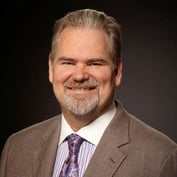Christopher Olsen of Olsen and Associates has been doing international investing for a long time. “Maybe 20 years ago we started using Allocation Master software, based on Nobel Prize-winning diversification theory,” he said. The software “tells me how much is going into various categories, and international is one of them. I pretty well stick with that.”
“The bulk of [what I use] is diversified international funds, not U.S.,” Olsen said. Early on he “used to find ‘international’ funds that had 80% [invested in the] U.S.,” with the rest invested in Mexico and Canada, “and they called themselves an international fund.”
Finding true international funds used to be one of his biggest challenges in those early days. In fact, he “got burned in ’99 because the mutual funds touted [themselves as] international, and we didn’t have as good tools in ’99 [to do the research].” When the market went down that year, he learned that the fund he was using “mirrored the NASDAQ almost perfectly, and had lots of tech companies—Cisco, IBM—and said [to justify those companies’ presence], ‘They all sell internationally.’” Diversification, he said, “is more important than trying to pick a certain sector.”
Now, however, the job is easier, and true international funds provide that diversification for his clients, both in stocks and bonds. While he doesn’t favor one region or country over another, emerging markets have provided some boosts to client portfolios as the Allocation Master software steered him in that direction. “For the last few years, when we went through the ‘Greece is going to leave the Euro’ [period], my models called for adding to international, which I did.” And clients have been pleased with the results.
Of course, just because he gets clients invested in the right areas doesn’t mean that the way is smooth sailing. There’s always the emotional factor that can kick in even when the news is good. He told of one client who had made a considerable amount in emerging markets during the recession, when U.S. markets were tanking.
“She needed money for something,” he said, and sold off some of her investments.” Of course that left her open to taxes on capital gains—something she had not considered. In June or July of 2011, he said, she e-mailed him to say “she was upset; she had such huge gains on emerging markets that when she did her taxes she owed a bunch of money.” She hadn’t been upset at the “risk” of international investing, but the “loss” to taxes of some of what she made bothered her.
That’s not the only kind of emotion to intrude. Interestingly, while many of his clients want to avoid risk altogether, some of his elderly clients actually have an appetite for risk. “I had a cycle of investing where [my clients’ reaction] was more emotional, as opposed to financial,” he said; “when [the market is] higher they’re euphoric, and when it’s low they’re scared.”








 February 25, 2014 at 08:20 PM
February 25, 2014 at 08:20 PM










